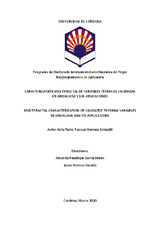Mostrar el registro sencillo del ítem
Caracterización multifractal de variables térmicas validadas en Andalucía y sus aplicaciones
| dc.contributor.advisor | García-Marín, A.P. | |
| dc.contributor.advisor | Estévez Gualda, Javier | |
| dc.contributor.author | Herrera Grimaldi, Pascual | |
| dc.date.accessioned | 2020-07-21T07:41:56Z | |
| dc.date.available | 2020-07-21T07:41:56Z | |
| dc.date.issued | 2020 | |
| dc.identifier.uri | http://hdl.handle.net/10396/20317 | |
| dc.description.abstract | Esta tesis doctoral analiza variables térmicas desde distintas perspectivas para profundizar en el conocimiento detallado de su comportamiento en la Comunidad Autónoma de Andalucía, centrándose especialmente en el rango térmico diario (DTR, del inglés Diurnal Temperature Range), definido como la diferencia diaria entre la temperatura máxima y mínima del aire. Para ello se ha trabajado con datos de temperatura máxima y mínima distribuidos por la región antes mencionada. En primer lugar, se ha llevado a cabo un control de calidad de las series de datos, como requisito básico para obtener resultados verosímiles y de confianza. Para ello se han aplicado distintos procedimientos de validación que permiten detectar registros erróneos y/o sospechosos y, en su caso, descartarlos. En una segunda fase se han obtenido las características multifractales de las series resultantes tras el proceso de validación, con el objetivo de analizar la naturaleza multiescalar de la variable. Para ello se han aplicado dos formalismos multifractales, declarando ambos al rango térmico diario como variable multifractal, con un comportamiento diferencial entre distintas zonas de Andalucía. Además, se han obtenido distintos intervalos temporales para los cuales la variable ha mostrado invarianza de escala. Posteriormente, se ha aplicado la metodología del análisis regional de frecuencias (ARF) para estudiar la distribución espacial de la variable. Tanto la variable DTR diario, como el DTR máximo anual, no siguen patrones homogéneos en Andalucía. Finalmente, en base a los resultados anteriores y para profundizar en la caracterización térmica, se ha llevado a cabo un análisis de tendencias y homogeneidad de diversas series de temperatura en distintas zonas geográficas de clima mediterráneo, donde en general, se han obtenido tendencias positivas. La mayoría de los puntos de cambio detectados en las series analizadas tuvieron lugar en los primeros años de la década de los 80 y la primera mitad de los 90, del pasado siglo. | es_ES |
| dc.description.abstract | This phD thesis analyses thermal variables from different perspectives to deepen on the detailed knowledge of their behaviour in the Autonomous Community of Andalusia, focusing specially on the Diurnal Temperature Range (DTR), defined as the difference between the maximum and minimum daily air temperature. For this, we have worked with maximum and minimum temperature data distributed by the region. Firstly, a quality control of the temperature data series has been carried out, as a basic requirement to obtain credible and reliable results. For this, different validation procedures have been applied that allow detecting suspicious/erroneous records and discarding them, if applicable. In a second phase, the multifractals characteristics of the resulting series after the validation process have been analysed, with the aim of studying the multiscale nature of the variable. For this, two multifractals formalisms have been applied, both declaring the daily thermal range as a multifractal variable, with a differential behaviour between different areas of Andalusia. In addition, different time intervals have been obtained for which the variable has shown scale invariance. Subsequently, the regional frequency analysis methodology has been applied to study the spatial distribution of the variable. Both the daily DTR variable and the maximum annual DTR do not follow homogeneous patterns in Andalusia. Finally, based on the previous results and to deepen in the thermal characterization, an analysis of trends and homogeneity of various temperature series has been carried out in different geographical areas of the Mediterranean climate, where in general, positive trends have been obtained. Most of the break points detected in the analysed series took place in the first years of the 80s and the first half of the 90s of the last century. | es_ES |
| dc.format.mimetype | application/pdf | es_ES |
| dc.language.iso | spa | es_ES |
| dc.publisher | Universidad de Córdoba, UCOPress | es_ES |
| dc.rights | https://creativecommons.org/licenses/by-nc-nd/4.0/ | es_ES |
| dc.subject | Temperatura | es_ES |
| dc.subject | Rango térmico diario | es_ES |
| dc.subject | Variables térmicas | es_ES |
| dc.subject | Series térmicas | es_ES |
| dc.subject | Análisis multifractal | es_ES |
| dc.subject | Análisis regional de frecuencias | es_ES |
| dc.subject | Andalucía (España) | es_ES |
| dc.title | Caracterización multifractal de variables térmicas validadas en Andalucía y sus aplicaciones | es_ES |
| dc.title.alternative | Multifractal characterization of validated thermal variables in Andalusia and its applications | es_ES |
| dc.type | info:eu-repo/semantics/doctoralThesis | es_ES |
| dc.rights.accessRights | info:eu-repo/semantics/openAccess | es_ES |

